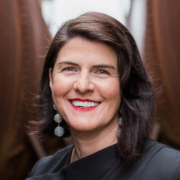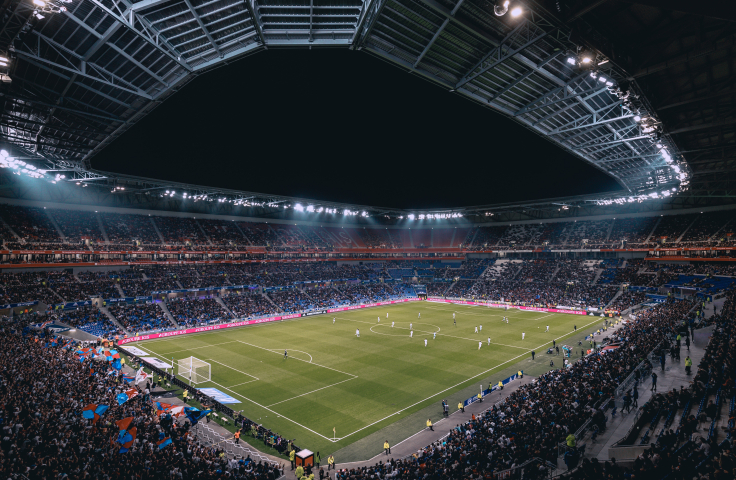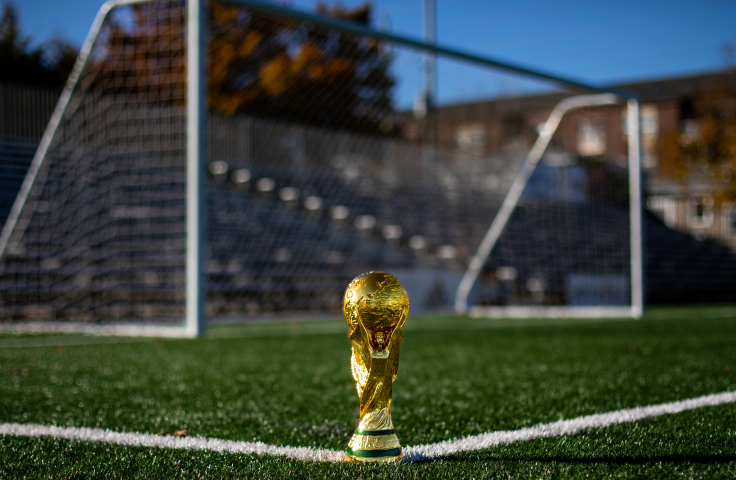Nikki Dryden is a two-time Olympic swimmer and a sport and human rights lawyer. She is an Associate at the Australian Human Rights Institute and Fulbright Global Research Scholar looking at athlete human rights in the sports dispute system. Nikki is also a board member and trustee at the Centre for Sport and Human Rights.
From 20 July-20 August, 1.5 million spectators in 10 stadiums across the two countries will watch 32 countries compete for the 2023 FIFA Women’s World Cup, jointly hosted by Australia and Aotearoa New Zealand.The tournament will be watched by two billion viewers. Athletes, coaches, sponsors, volunteers, referees, administrators and fans will be inspired by the women’s version of ’the beautiful game’.
With less than two months to go, the runway for improving Australia’s human rights record and ensuring Australian soccer is transformed for the better might be too short; a lost opportunity for the sport and human rights movement. But it may provide a lesson for the green and gold decade of mega sporting events (MSEs) to come.
What is FIFA and what is its role in promoting human rights?
FIFA is the world governing body for world football (or soccer). It is a non-profit based in Switzerland where most international sporting federations are headquartered, but nothing about its income looks like a charity. FIFA’s 2022 revenue was almost USD$5.77 billion. This year’s 32 participating teams will vie for USD$115 million in prize money, a 300% increase in from the 2019 WWC and 10 times what it was in 2015.
FIFA is a leader on sport and human rights in the international sporting movement. Regardless of why it started on this path, FIFA was the first sporting body (and remains one of the largest) to adopt a Human Rights Policy and incorporate human rights into their governing statutes and regulations. It spent four years responding to an expert Human Rights Advisory Board and has human rights, safeguarding and accessibility rights teams reporting to a Sustainability Head. It debuted a human rights volunteer monitoring program at the 2022 FIFA Men’s World Cup (MWC) and has a human rights grievance mechanism.
(For an in depth look at FIFA, its responsibility to respect and promote human rights connected to their activities, and its specific role regarding the MWC in Qatar, read Brendan Schwab’s explainer.)
Most other global sports bodies are floundering on human rights; it took the International Olympic Committee (IOC) six years before following FIFA’s lead in developing their own Strategic Framework on Human Rights. But putting human rights on paper is just the first step. One of the reasons that FIFA remains in the crosshairs of human rights activists and athlete advocates is that real change won’t occur until there is a transformation of the culture of world sport; one that puts athletes at the centre of sport.
What are some of the biggest human rights issues facing the 2023 WWC?
In December 2021, after six months of consultation with more than 180 individuals from 115 organisations (including the Australian Human Rights Institute), the Australian Human Rights Commission and the New Zealand Human Rights Commission published an extensive Human Rights Risk Assessment for FIFA. The document was a blueprint for how FIFA, the host countries and the host football federations could and should engage with and address human rights risks related to the WWC tournament. The risk assessment included recommendations to address the 57 salient risks associated with hosting this event. It also included ‘legacy’ opportunities, that is the opportunity to ensure the sport and the enduring impact of the major event, sets soccer on a path for future improvement in its operations and impact.
Five key areas were identified as potential risks: athlete rights, worker rights, media risks, events risks and gender equality, intersectionality, and discrimination. Of the risks raised, 21 earned a Tier 1 rating, including Indigenous people's rights and athletes' rights.
In response to the risk assessment, FIFA developed a Sustainability Strategy for the WWC which created a set of priorities and initiatives. FIFA’s response did not address all of the 57 risks or even all of the 21 Tier 1 risks.
Gender equality: What are the pay differences for men’s and women’s teams?
The Professional Footballers Australia (PFA) has done extensive work fighting for equal pay for the Matildas (the Australian women’s national team). A large proportion of funding for soccer in Australia comes from FIFA and is based on the success achieved in the World Cup tournaments. However, the pool of funding for women’s teams is far lower than that available for the men’s teams. For example, the Socceroos (the Australian men’s national team) received USD$13 million for reaching the Round 16 in Qatar. Compare that to the US women’s national team who received just USD$4 million for winning the WWC in 2019, and $2 million for their win in 2015. This is changing. In 2023 FIFA will increase the prize money for the WWC by 300%. However, that total figure is just over one third of the USD$440m given out at the 2022 men’s World Cup.
While the prize money increases are commendable, the global football players union FIFPro says it will keep fighting “for greater professionalisation of the FIFA Women’s World Cup: equal regulations and conditions, fair redistribution of prize money to players, and a pathway to equal prize money, as well as an agreement that protects these commitments – both now and as a legacy for the players in the future”. The provision of adequate funding is an issue of central importance to developing the women’s game around the world.
What is being done to address Indigenous inclusion?
The risk assessment recommendations included promoting and ensuring “respectful and genuine inclusion” of Australia’s First Nations People, including acceptance of the principles of self-determination, participation in decision-making, respect for and the protection of culture, and equality and non-discrimination. It is unclear if FIFA has taken up the recommendation to establish a co-designed programme for the development of a policy regarding investment back into First Nations communities where economic revenue is generated from the WWC being held on First Nations’ land.
However it is clear that the recommended consultation and inclusion has not happened to an adequate extent. Indigenous representatives in Australia and New Zealand signed a 'Football Treaty' ahead of the WWC that calls upon FIFA and the Australian Football Association (FA) to create a “new model that recognises self-determination, direct funding and recognition of Indigenous representative teams”.
The treaty between the Australian Indigenous Football Council (AIFC) and the Māori Football Aotearoa (MFA) is supported by the PFA and former Socceroo Craig Foster, who said: "The support of Football Australia for the Uluru Statement from the Heart — along with so many other sports — is welcome and symbolically important. Now, the next step is to bring that statement to life through Indigenous-managed and led programs.”
Award winning journalist Tracey Holmes has reported extensively on the WWC and interviewed AHRC commissioner Lorraine Finlay this year. Finlay told Holmes that the number and type of risks identified in 2021 were not surprising, but she followed: "What's important is what comes next — what do you do when you identify those risks? How do you address them? How do you actually put things into action to make sure that those risks aren't borne out? "
What steps has FIFA taken on human rights ahead of the WWC?
FIFA’s Sustainability Team is responsible for several major efforts to improve human rights including on safeguarding, remedy, and real-time human rights risk assessments.
There is an impressive amount of work being done to educate member associations that will attend the WWC including players, coaches, administrators, and entourages about FIFA’s Safeguarding Policy and programs, and how they apply during the tournament. FIFA along with the IOC are leading global sport in safeguarding, both with programs to educate member associations and help them develop policies and processes to make sport safer for all participants.
While remedy for human rights violations that occur in sport is weak, FIFA is one sport that has a general grievance mechanism that can be used to report a human rights concern “in relation to FIFA’s activities and events”. Anyone can report a human rights matter to FIFA by email or using their online portal. However, unlike for the men’s World Cup in Qatar, there doesn’t appear to be a WWC tournament-specific grievance mechanism.
It is essential that the Australian and New Zealand governments, civil society and sporting organisations ask and receive non-confidential information and statistics about human rights issues connected to our hosting of the WWC. It is this transparency, reporting and learning that is often absent from efforts by sport to address human rights issues.
For the 2021 Arab Cup and 2022 men’s World Cup, FIFA partnered with the Centre for Sport and Human Rights to create and deliver a unique Human Rights Volunteer Programme. This was the first time such a programme was delivered at a MSE. Volunteers were trained with support from the UN Human Rights Office to conduct real-time human rights risk assessments through interviews with fans, observations and assisting participants with using FIFA’s grievance mechanism.
This program is not being used for the WWC. Instead, expert consultants will be available for face-to-face human rights and safeguarding complaints supported by volunteers through FIFA’s tournament volunteer program that includes accessibility, climate, human rights and safeguarding trained volunteers.
Online athlete abuse is at a crisis point, what can we expect during the WWC?
Sports, from tennis to European football, are rife with racist, sexist and homophobic fan attacks on players. In 2020, three English footballers – Bukayo Saka, Jadon Sancho and Marcus Rashford – received racist abuse online after missing their penalty kicks in the European final shootout where England lost. In Australia, such abuse is visible in a range of sports and thirty years on from Nicky Winmar’s strong pose against racism, issues persist.
FIFA and FIFPro released a report in 2022 which examined 400,000 social media posts on Twitter and Instagram, finding 541 cases of direct discrimination or other forms of abuse. “The study showed that 40% of abusive messages contained homophobic content, and 38% were racist. A further 3% were categorised as containing a threat.”
FIFA and FIFPro then launched a social media protection service providing players with a dedicated monitoring, reporting and moderation service for the 2022 MWC. The service, using learnings from Qatar, will be in place for the WWC.
According to FIFA, the software is meant to “scan recognised hate speech terms published to identified social media accounts, and once detected, prevent that comment from being seen by the recipient and their followers.” The program also involves educational support and best practice advice for players on how to manage social media accounts and provides them with mental health advice.
While the program is commendable it fails to address the root causes of racial, sexist and homophobic abuse of athletes both in stadiums and online, it is a Band-Aid on larger social issues that exist and which sport has allowed to fester. It’s not a coincidence that most international and Australian sporting organisations are run by white men. Sport continues to negatively contribute to racial and gender stereotypes through its inability to implement governance reform and culture change that engages effectively with affected stakeholders and truly realises diversity and inclusion that reflects our societies.
For the women’s game the lack of equality (from pay to status) fuels the notion that women athletes are ‘less than’ and can be treated that way online. Full recognition of women as equal athletes is needed and part of that comes from involving women in decision making positions in media companies, in sponsorship talks, and in international sporting federations. Until women are in leadership positions, we will continue to hear anecdotes like, ‘fans/broadcasters won’t pay for women’s sport’. Tell that to women’s cricket, where just five franchises for the new Women’s Premier League were sold for a total of AUD$800 million and the five-year television rights another AUD$170 million. The league is only three weeks long and these prices are higher than when the men’s version debuted 15 years ago. In addition, some players will earn more than AUD$500,000 for three weeks.
How can we avoid complicity in sportswashing?
We are all very quick to call out Saudi Arabia, Qatar and China when it comes to hosting MSEs and their human rights records, but are we willing and able to look in the mirror and say we did enough here in Australia and Aotearoa New Zealand?
In an article for the Carnegie Endowment offering a Qatari perspective on sportwashing, it was argued that “the hosting of the World Cup fostered increased local awareness regarding the state’s commitment to enacting legislation that respects human rights and prevents violations”.
Can we say the same here in Australia? Will the WWC foster any increased awareness in Australia’s laws that violate international human rights law? AHRC Commissioner Finlay notes: "If we want to be able to shine a spotlight on other countries and criticise them for their human rights violations, we need to subject ourselves to that same scrutiny."
In order to make progress as we move to the Commonwealth Games in 2026 and the Olympics and Paralympics in 2032 we need real change. Sport needs to entrench human rights in its policies and operations, put athletes at the centre of sport, embrace good governance, and embed integrity deep into the fabric of how sport is run, governed and showcased. More importantly, we must be unbiased about our own failures to uphold human rights and how sport contributes to the continued washing of racial and gender inequalities, abuse, discrimination and even violence. Until we do, the fight continues.
*Disclosure: I interviewed with FIFA for the position of Human Rights Manager and did not get a call back.


